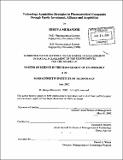| dc.contributor.advisor | Edward B. Roberts. | en_US |
| dc.contributor.author | Muranishi, Hiroya, 1964- | en_US |
| dc.contributor.other | Massachusetts Institute of Technology. Management of Technology Program. | en_US |
| dc.date.accessioned | 2005-08-23T20:25:24Z | |
| dc.date.available | 2005-08-23T20:25:24Z | |
| dc.date.copyright | 2002 | en_US |
| dc.date.issued | 2002 | en_US |
| dc.identifier.uri | http://hdl.handle.net/1721.1/8469 | |
| dc.description | Thesis (S.M.M.O.T.)--Massachusetts Institute of Technology, Sloan School of Management, Management of Technology Program, 2002. | en_US |
| dc.description | Includes bibliographical references (leaves 120-121). | en_US |
| dc.description.abstract | The pharmaceutical industry is now confronted with a discontinuous time period, especially in terms of its technology. In order to maintain their advantageous positions in the industry, pharmaceutical companies have to invest not only in internal R&D but also in external sources, since technologies in the industry are too broad to enable a company to cover all of the new technologies. Allotment of investment in internal and external R&D, however, is hard to determine; moreover, the selection of targets and styles of external technology acquisition by pharmaceutical companies requires deep deliberation on all the scientific and business aspects. In this thesis, I have analyzed the correlation between technology acquisition activities and the internal technological strength, or product development, in nine pharmaceutical companies in three countries: U.S., Japan, and Germany. Styles of technology acquisition deals vary among the three countries. German companies showed the most aggressive technology acquisition strategies in overall technology deals. U.S. companies exhibit strong technology acquisition strategies with prominent equity investment deals. Japanese companies were discreet about their technology acquisition deals, although they showed a similar degree of eagerness for product acquisition. The number of technology acquisition deals by Japanese companies, however, has increased during the past two or three years. A positive correlation between the number of all deals and product development (the number of pre-clinical drug candidates) was detected. On the other hand, there is no clear correlation between technology creation deals or technology frontier deals and product development. In order to assimilate the growing amount of external property, pharmaceutical companies must consider setting up an appropriate management organization because the deals between biotech enterprises and pharmaceutical companies involve dissimilar organizations in terms of culture, size, power, and expertise. I studied the organization of alliance management in Eli Lilly as an example. | en_US |
| dc.description.statementofresponsibility | by Hiroya Muranishi. | en_US |
| dc.format.extent | 121 leaves | en_US |
| dc.format.extent | 6949420 bytes | |
| dc.format.extent | 6949178 bytes | |
| dc.format.mimetype | application/pdf | |
| dc.format.mimetype | application/pdf | |
| dc.language.iso | eng | en_US |
| dc.publisher | Massachusetts Institute of Technology | en_US |
| dc.rights | M.I.T. theses are protected by copyright. They may be viewed from this source for any purpose, but reproduction or distribution in any format is prohibited without written permission. See provided URL for inquiries about permission. | en_US |
| dc.rights.uri | http://dspace.mit.edu/handle/1721.1/7582 | |
| dc.subject | Management of Technology Program. | en_US |
| dc.title | Technology acquisition strategies in pharmaceutical companies through equity investment, alliance and acquisition | en_US |
| dc.type | Thesis | en_US |
| dc.description.degree | S.M.M.O.T. | en_US |
| dc.contributor.department | Management of Technology Program. | en_US |
| dc.contributor.department | Sloan School of Management | |
| dc.identifier.oclc | 50700783 | en_US |
